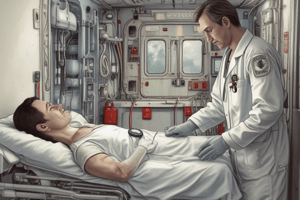Podcast
Questions and Answers
When you use the palpation method to obtain a blood pressure, the measurement you obtain is the:
When you use the palpation method to obtain a blood pressure, the measurement you obtain is the:
- Diastolic blood pressure
- Pulse pressure
- Cardiac output pressure
- Systolic blood pressure (correct)
Which of the following findings indicates that your patient has a patent airway?
Which of the following findings indicates that your patient has a patent airway?
- Audible breathing
- Inspiratory stridor
- Ability to speak (correct)
- Unresponsiveness
Which of the following is an example of a symptom?
Which of the following is an example of a symptom?
- Hypertension
- Headache (correct)
- Tachycardia
- Cyanosis
Which of the following medical history questions would be of LEAST pertinence in an acute situation?
Which of the following medical history questions would be of LEAST pertinence in an acute situation?
Which of the following would the EMT likely NOT perform on a responsive patient with a headache and no apparent life-threatening conditions?
Which of the following would the EMT likely NOT perform on a responsive patient with a headache and no apparent life-threatening conditions?
Flashcards
Altered Level of Consciousness
Altered Level of Consciousness
A change in a person's awareness and responsiveness, generally not caused by acute anxiety.
Jugular Venous Distention
Jugular Venous Distention
Swelling of the jugular veins when a patient is at a 45-degree angle, indicating possible heart issues.
Capillary Refill Time
Capillary Refill Time
The time it takes for capillaries to regain color after pressure is released, normal in infants is under 2 seconds.
Primary Assessment Purpose
Primary Assessment Purpose
Signup and view all the flashcards
Bradycardia vs. Tachycardia
Bradycardia vs. Tachycardia
Signup and view all the flashcards
Study Notes
Patient Assessment Overview
- Altered level of consciousness is least likely caused by acute anxiety.
- Rapid, irregular pulse in a 62-year-old female with chest pain requires immediate transport and possible paramedic support.
- Secondary assessment should focus on the chief complaint area rather than performing a head-to-toe exam in every case.
Vital Signs and Monitoring
- A consistent pulse pattern indicates a regular pulse.
- As time progresses after an injury, the body's ability to compensate for shock decreases.
- Reassess unstable patients at least every 5 minutes.
Patient History and Evaluation
- A focused secondary assessment is appropriate when significant trauma is suspected.
- Jugular venous distention is notable in a patient sitting at a 45-degree angle.
- To determine a patient's chief complaint, ask “What seems to be the matter?”
Patient Examination Techniques
- When auscultating blood pressure, place the stethoscope over the brachial artery.
- Capillary refill in infants should return within 2 seconds, indicating adequate perfusion.
- In responsive patients over 1 year, the radial artery is typically assessed for pulse.
Signs and Symptoms Interpretation
- Cyanosis indicates decreased blood oxygen; flushed skin may suggest high blood pressure.
- Stridor is a high-pitched sound indicating upper airway obstruction.
- A palpable pulse results from pressure waves in the arteries due to cardiac contraction.
Emergency Protocols
- Perform the primary assessment to identify and treat life-threatening conditions.
- In cases of suspected spinal injury, maintain head stabilization while assessing.
Reassessments and Interventions
- After primary assessment, perform a rapid exam to identify any less obvious injuries.
- Start interventions like assisting ventilation in unresponsive patients showing distress.
- The second assessment may not occur if managing ongoing life threats.
Specific Patient Conditions
- Jaundice in a patient hints at liver dysfunction.
- Abdominal pain in a conscious patient can indicate various conditions; assess vital signs and transport appropriately.
- Bradycardia is a pulse rate under 60 beats/min; tachycardia is over 100 beats/min.
General Knowledge about Assessment
- Know that systematic head-to-toe exams are reserved for significant mechanism of injury and unresponsive patients.
- Blood pressure cuffs should cover about two-thirds of the arm length from armpit to elbow crease.
- Assess pupils for reaction—normal response is constriction when light is shone.
Musculoskeletal and Respiratory Assessments
- In patients with head injuries, assess motor function by asking them to wiggle toes on command.
- Seesaw breathing, a sign of respiratory distress, is primarily observed in pediatric patients.
Important Medical History Considerations
- A medical alert bracelet is vital to check in unconscious patients for historical flags.
- Headaches can often be a symptom rather than a definitive clinical sign.
Conclusion on Effective Practices
- Standard precautions should always be taken before patient contact.
- The goal for oxygen saturation is typically set at 94% to 99% for most patients.
- Assess interventions during reassessment for effective patient management and safety.
Studying That Suits You
Use AI to generate personalized quizzes and flashcards to suit your learning preferences.



